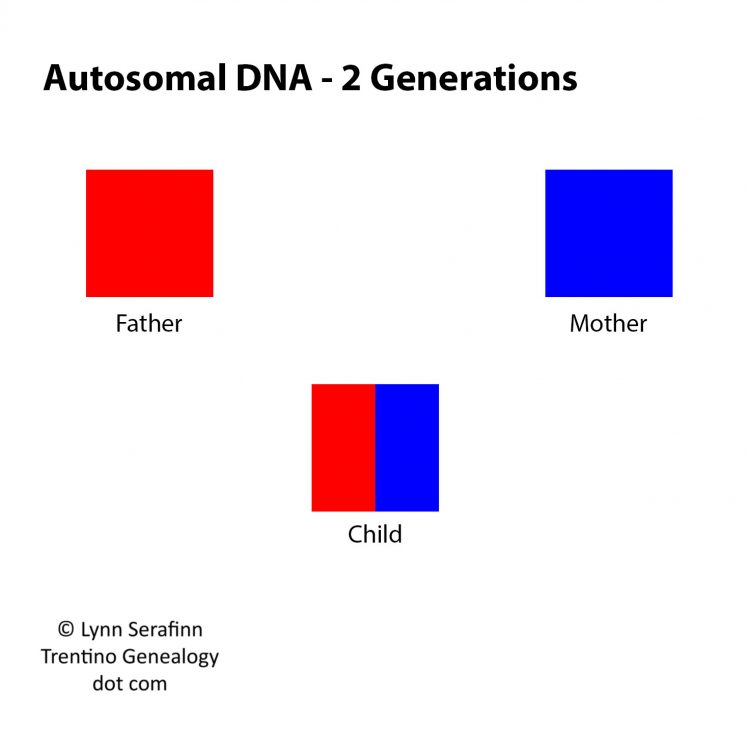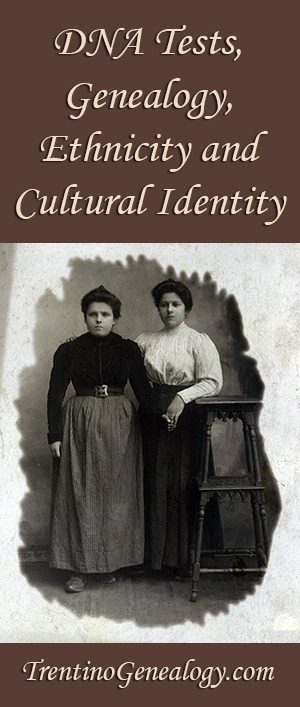
Article 1 of 4. Genealogist Lynn Serafinn discusses fundamentals of genetics, Y-chromosome, mitochondrial and autosomal DNA tests and pedigree collapses.
Over the past few months on social media (especially on Facebook), I have been watching with interest a marked increase in conversations about DNA testing and its relevance to genealogy. This has been especially noticeable in groups exploring their northern Italian and/or Trentino ancestry. Amongst those of northern Italian descent, the ‘heated debates’ were mostly in response to AncestryDNA’s new algorithms for their ethnicity reports, which have suddenly – and seemingly inexplicable – relabelled many of us (including me) ‘French’.
As I watch people’s reactions to their DNA test results and ethnicity reports (from ANY DNA testing service, not just Ancestry) I see they are frequently confused, sometimes disappointed, and occasionally upset. I have often added my own opinions and insights when I see these online conversations, but the nature of social media is that the impact of any kind of complex discussion is often fragmented.
For that reason, I decided to write this series of articles, where I will do my best to address what I believe are the most common causes of these understandable emotions amongst DNA testers:
- Unrealistic expectations about DNA testing (largely due to misleading media hype and advertising).
- Minimal or insufficient understanding of genetics in general.
- Insufficient genealogical research of their own ancestry.
- Misunderstanding the difference between ethnicity, nationality and cultural identity.
- Lack of knowledge of the history of their ancestral homelands.
- Lack of understanding of how ethnicity reports are created, and what the information actually MEANS.
My purpose in writing this series is to help you become better informed on the subject, and not to discredit any of the DNA tests currently on the marketer or put readers off the idea of taking a DNA test. Quite the opposite, in fact: I believe that the more people of specific ancestries get tested, the more accurate and USEFUL the results will gradually become. I also believe we can make an impact on the future of research, when we combine DNA with meticulously-documented, traditional genealogy.
How the articles are organised:
- Article 1 (today’s article) will cover topics 1 and 2, where we will look at DNA tests and some basics about autosomal DNA.
- Article 2 in the series covers topic 3, looking at how DNA tests can often point us in a direction, but (usually) cannot give us specific answers about our ancestry or blood relations.
- Article 3 covers topics 4 and 5. This article will focus primarily on people of northern Italian descent, and more specifically those of us of Trentino descent, as our unique cultural identity plays a big role in how we might respond to DNA testing, both intellectually and emotionally.
- Finally, article 4 will focus solely on ethnicity reports, with examples from my own reports, so you can see how data can be interpreted (and misinterpreted) in context.
NOTE: Be sure to subscribe to the Trentino Genealogy blog using the subscription form at the right so you can receive all the articles in the special series on DNA testing. After the series is complete, I will also be compiling the articles into a FREE downloadable PDF available for a limited time to all subscribers. If you are viewing on a mobile device and cannot see the form, you can subscribe by sending a blank email to trentinogenealogy@getresponse.net.
DISCLAIMER: I am NOT a scientist or a geneticist. Nor am I an historian in the academic sense of the word. I am a genealogist and author specialising in the people of Trentino. I was a college teacher for many years, and I still teach workshops in Italian genealogy to various groups. Many years ago, I did post graduate work in social anthropology and world music. I have read a lot, observed a lot and researched a lot within the parameters of my work and my lifelong passion for social and cultural history. Genetics has always been a fascination of mine, as it plays a huge role in our understanding of our family histories, and our personal identities. I have done autosomal DNA testing through both AncestryDNA and 23AndMe, and I have also uploaded my raw data files to both GEDMatch and FamilyTreeDNA. Just this week, I also ordered autosomal and mtDNA tests from CRI Genetics (so I cannot comment on them in this article). Please bear my ‘mixed bag’ background in mind as you read this series. I would not wish to create yet more ‘unrealistic expectations’ for you by posing myself as an expert in genetics. I really am just like most people – learning as I go along.
PART 1: Our Unrealistic Expectations About DNA Testing
As a professional genealogist, I have subscriptions to just about every relevant genealogy website on the Internet. And when you have a lot of web subscriptions, you are also on a lot of mailing lists. So, it came as no surprise to me over the recent Christmas season that I received dozens of marketing emails from every genealogy site to which I subscribe, suggesting I buy their products as Christmas presents for friends and family members. And one of the number one ‘gifts’ being flogged this year by all the major sites this year was DNA testing kits.
Unfortunately, many of these marketing campaigns can create unrealistic expectations in their customers. With regards to ancestry (I’m not considering health reports or those for genetic traits), you will see two main promises:
- ETHNICITY: Marked by catch phrases like ‘discover your ancestors’ origins’ or ‘uncover your ethnic mix’.
- CONNECTION: Marked by catch phrases like ‘connect with relatives’, ‘discover long-lost family’ or ‘meet a distant cousin’.
The trouble is, NEITHER of these promises is 100% honest, and both are somewhat misleading.
Later in Article 3, when we look at ethnicity reports, we’ll see how and why ethnicity and ancestral origin reports are usually very ‘woolly’, imprecise, and often downright WRONG.
And while the media (and marketing campaigns) love to focus on success stories of people who were reunited with parents, siblings and other close relations after doing a DNA test, for most people, the reality of connecting with blood relations through DNA testing is much more challenging, as we will also see later.
Three Types of DNA Tests
Before you decide to spend your money on any DNA test, I strongly advise getting clear about what you wish to gain from being tested. Knowing what you want will determine which of the tree main types of DNA tests is best for you:
- Y-DNA – This test is specifically to trace your patrilineal ancestry (your father, his father, his father’s father, etc.). It is only available to men (as women don’t have a Y chromosome), but a female can explore this by asking her father, brother or a male cousin (he MUST be a son of her father’s brother) to get a Y-DNA test. This test is good if you are interested in tracing the history of a surname, for example. I have one client who is using Y-DNA testing to reconstruct the history of a specific Trentino family throughout the centuries.
- Mitochondrial (mtDNA) – This test is for tracing your matrilineal ancestry (your mother, her mother, her mother’s mother, etc.). Both men and women can take an mtDNA test, as we all inherit this from our mothers. Be aware that it does NOT tell you about all your female ancestors (i.e. it cannot tell you about your paternal grandmother, the mother of your maternal grandfather, etc.), but only the direct line of females from your mother back in time.
Both Y-DNA and Mitochondrial DNA change very slowly over time, which means these kinds of tests can reveal more about your ancient ethnicity/ancestry than autosomal testing. If you are interested to see how some scientists have used these tests to trace the ancient ancestry of one man, I highly recommend checking out the 2-part BBC television series ‘Meet the Izzards’. You can find it on YouTube at these links:
Meet the Izzards Part 1 – ‘Mother’: https://youtu.be/DIp_xtQelWA
Meet the Izzards Part 2 – ‘Father’: https://youtu.be/vMHQA2nS7tA
- Autosomal – This is the most commonly chosen and widely available DNA test, and only one currently offered by companies like AncestryDNA and 23AndMe. You would choose this kind of DNA test you if you are interested in your more recent ethnicity (the last few hundred years) and/or connecting with living people who are biologically related to you. Autosomal tests are also used by companies (23AndMe is an example) to create health profiles, showing which genes you have that may indicate a higher risk of developing certain diseases or conditions, or sensitivity to certain medications. Autosomal tests can also be used for discovering inherited traits, such as eye colour, the ability to roll your tongue, etc. Autosomal DNA tests are available to both men and women.
*** NOTE: I will ONLY be discussing AUTOSOMAL testing in this article series. ***
Choosing the Right Company
Aside from choosing the right test, your reasons for choosing one company over another should ideally have more to do with what they offer (and how that relates to what you want) than with price:
- If your primary aim is to trace your patrilineal or matrilineal ancestry, there are currently only a few companies offering Y-DNA and/or mtDNA testing. FamilyTree DNA, National Geographic, CRI Genetics are the ones I know of, but there may be others.
- If your primary aim is to get a health profile, then you might look into 23AndMe. CRI Genetics also has a health report, but I haven’t had it done, so I cannot say how detailed it is.
- If your primary aim is to connect with living relatives (bearing in mind the caveats we’ll discuss later in this series), you would do best to go with the company with the biggest database of DNA testers, which is currently AncestryDNA.
- If you’re really serious about finding living relatives, you would do better to get tested through multiple companies. The bigger the ‘net’ the more likely to ‘make a catch’.
- If your primary aim is to get an ethnicity profile of your recent ancestry, pretty much all the testing companies will give this to you via autosomal DNA testing. However, as we’ll see later in this series, the results you will get are not always as precise as you might like. Also, as we will see, autosomal DNA (or at least our current understanding of it), by its very nature, cannot show details extending much further back than around 250 years (NOTE: that is an arbitrary figure I am gleaning from AncestryDNA’s ethnicity reports). Based on reviews, companies like FamilyTreeDNA and CRI Genetics seem to have a better reputation for accuracy and precision than Ancestry does, but I cannot yet vouch for either personally.
Rather than trying to review all the tests themselves (and they are bound to change over time anyway), I refer you to two good articles that compare a range of DNA tests available as of this date (albeit the one on the Family DNA site is predisposed towards their own product):
- ‘3 Mistakes to Avoid When Shopping for a DNA Test: Your Free Guide to the Best Valued DNA Tests’ (2017). https://geneticsdigest.com/best_ancestry_genealogy_dna_test/index.html
- ‘The 6 Best DNA Tests for Ancestry 2018 – Which Testing Kit Is Right for You?’ at https://www.myfamilydnatest.com/.
PART 2: Entry Level Genetics for Genealogists and Family Historians
Before dipping your toes into your chromosomes, I think it is important to understand a few basics about genetics in general. I don’t mean the scientific side so much as how it ‘works’ in our ancestral inheritance. To that end, I want to explain a little bit about autosomal DNA and how it is transmitted over time, as autosomal tests are the basis for the ethnicity reports people receive from most DNA testing services.
Autosomal DNA – Understanding the Basics
The following illustration gives us an idea of how autosomal DNA is passed on from parents to a child. It looks very simple; each parent gives 50% of his/her DNA to the child:
Click on image to see it larger in a new window.
While, in principle, this seems simple, in reality, it is more complex than it looks.
Why? Because Father and Mother are not just ‘all red’ or ‘all blue’. Each of them has inherited 50% of their genes from their OWN parents.
Again, in principle, that sounds like it would be simple. Logically, it would mean the child inherits 25% of their genetic material from each of their grandparents. But, in practice, this is not exactly what happens. We can understand this better if we look at two children from the same couple:
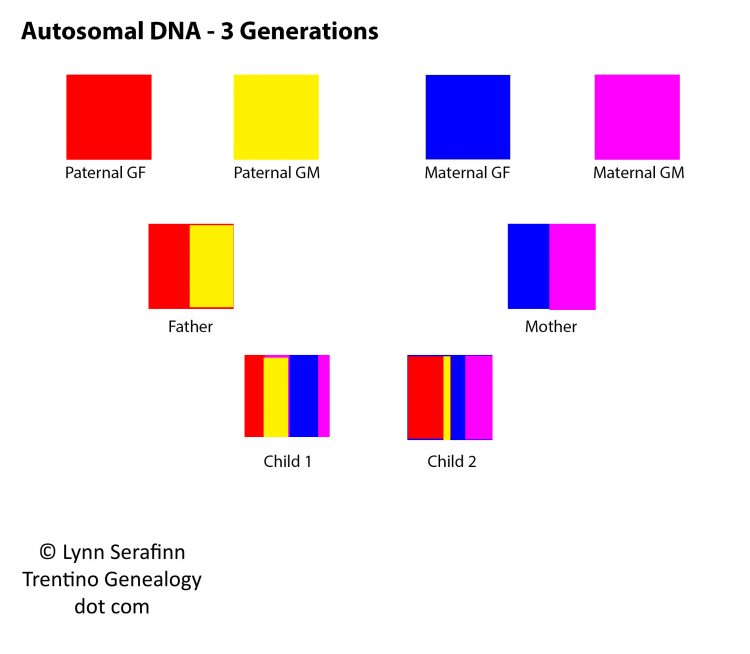 Click on image to see it larger in a new window.
Click on image to see it larger in a new window.
(Forgive any slight imprecision in the diagram; I did it by hand in Photoshop, and I’m not a graphic designer).
In the diagram above, we see three generations of autosomal DNA. Now, we see Father has inherited 50% of his DNA from his parents (red and yellow), and Mother has inherited 50% of her DNA from her parents (blue and purple).
But look, now, at the children. Each child has inherited 50% of their DNA from each of their parents. HOWEVER, the percentage of DNA from each ‘colour’ (i.e. each grandparent) is NOT an exact 25%. They receive more from one grandparent, and less from the other, until it adds up to the full 50% from that parent.
Note how Child 1 has a lot more yellow and blue DNA than Child 2, and Child 2 has a lot more red and purple DNA than Child 1 has. This is what makes siblings unique (except for identical twins, whose DNA are identical).
But it gets even more complicated, the more we work through the generations. Here’s a diagram of the same family with their great-grandparents added into the mix: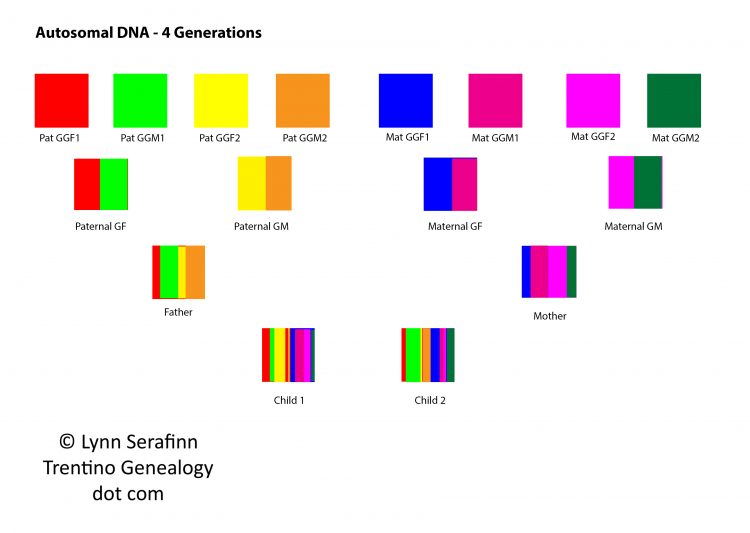
Click on image to see it larger in a new window.
From this diagram, we can see yet more diversity entering the ‘gene pool’. At each generation, children have inherited 50% of their DNA from their parents, but now (at least from Father and Mother down) we see how they continue to inherit DNA from their grandparents and the ancestors who came before in varying proportions.
Now, when we look at the two children, we see even greater diversity between them. Child 2, for example, carries a lot more DNA from their father’s paternal grandmother (green) than his/her sibling does.
But the OTHER thing we start to notice is how the slices of DNA are getting smaller, as they combine and recombine to fill in the 50% from each parent. This is an important point:
The AMOUNT of autosomal DNA
we inherit from specific ancestors
DECREASES over time.
Try to imagine, now, if I added another generation to this diagram…and then another, and another, ad infinitum. Not only would some of those colours become so narrow they would be hard to detect (and I would certainly have a rough time drawing them in Photoshop), but SOME of those colours might not appear in DNA tests at all.
This is why:
- Siblings can sometimes receive slightly different ethnicity reports from the autosomal tests. It doesn’t mean they HAVE different ethnicities. It just means that one of them has genes that appear more in one ‘test group’ than the other (we’ll discuss test groups in the final part of this series).
- One sibling might have a DNA match on Ancestry, etc. which the other sibling does not share. It doesn’t mean they are NOT both related to the DNA match. It just means that the specific genes they inherited matched the specific genes the ‘match’ inherited. In fact, one sibling could inherit the DNA from an ancestor whose DNA is completely absent in their siblings’ DNA.
- Autosomal testing CANNOT really tell us our ‘ancient’ or ‘deep’ ancestry. Autosomal DNA is changing EVERY generation, whereas Y-DNA and mitochondrial DNA (which CAN tell us our ancient ancestry) are not. So, don’t go into autosomal testing expecting to discover very ancient ancestral roots.
The Mysterious Case of ‘Faded Genes’
Scientists tell us we could indeed be a direct descendant of someone without having inherited ANY of that person’s DNA. The more distant our relation to an ancestor, the more likely this becomes.
While that is the ‘official’ belief amongst scientists, I personally believe we carry DNA of each and EVERY one of our ancestors inside of us, from the beginning of time – even if only in an infinitesimally small quantity.
I confess this is an utterly UN-scientific belief. But having researched so many ancestors for myself and so many others, I have come to believe it to be true, at what I might call a ‘spiritual’ level.
If science cannot yet ‘detect’ the presences of all those ancestors in our genes, I believe it is more a measurement of the current technological limitations than an indication that ancient DNA simply ‘fades away’ over time.
Again, this is simply my personal belief. But I suspect many others (especially genealogists) feel similarly.
Endogamy and Pedigree Collapses
To finish our discussion on autosomal DNA, I feel it is important to touch upon the subject of ‘endogamy’, and how this related to both DNA testing and genealogy.
‘Endogamy’ refers to the practice of small, insular groups intermarrying over many generations – often over many centuries. Intermarriage within one’s own social group occurred amongst ALL human societies, pretty much until the beginning of the 20th century with the introduction of mass transportation. Having researched tens of thousands of families over the years, I would say that around 95% of the time, couples tended to marry within their own parish – and often within their own village/hamlet. Moreover, you will often see them intermarrying with the same families over the generations.
Continual intermarriage within a closed community will ALWAYS lead to the inevitability of some couples marrying who were related by blood. The technical term for a blood relationship is ‘consanguinity’ (literally ‘with blood’).
Many of us have heard stories about royal families intermarrying ‘too much’ (I’ll get to that in a minute), but the truth is consanguineous relationships between spouses occurs in ALL family trees, in all parts of the world, from the simple farmer up to kings and queens.
And the further you go back in time, the more of these ‘consanguineous’ ancestors you will find in your tree. In fact, when you start to plot out all the families in a parish over a long period of time (as I am doing for the parish of Santa Croce del Bleggio), you will start to see that pretty much EVERYONE alive today who is descended from someone in that parish is related to pretty much everyone else – whether they realise it or not. Moreover, if you look back in time to, say, around 500 years ago, you will see that pretty much everyone who was alive THEN in that parish is your ancestor.
It’s a bit mind-bending.
There isn’t a person on earth who, does not have at least some ancestors who married someone who was related to them by blood. It doesn’t mean they were closely related. 4th cousins, for example, were not considered ‘close’ in terms of canonical (Church) law. And more distant relations than that, people didn’t even CONSIDER were ‘related’ to them at all.
But while the Church and its parishioners might not consider 5th cousins and beyond to be ‘relatives’, from a genealogical perspective – and in terms of DNA – they most certainly are.
Every time you have a pair of consanguineous ancestors, it creates something called a ‘pedigree collapse’. Normally, we expect the number of our ancestors to multiply by two at each generation, as we move back in time. But when there is a consanguineous relationship between a husband and wife, it means they share a common ancestor (or, more frequently, a pair of common ancestors). Thus, when we move backwards in time to the generation at which their common ancestors occur, there will be FEWER than double then number of ancestors (minus two, to be precise).
Here are a couple of diagrams to illustrate what I mean: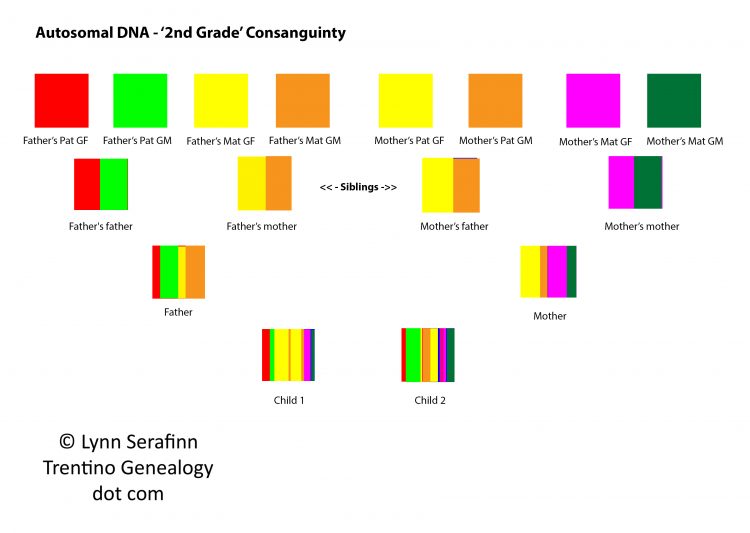
Click on image to see it larger in a new window.
In this diagram, Father’s mother and Mother’s father were brother and sister. This means that Father and Mother above are actually 1st cousins (In reality, most consanguineous marriages are more distant than 1st cousins, but this was the simplest diagram I could draw to illustrate a pedigree collapse). The Catholic church calls this ‘2nd grade consanguinity’ because the blood connection is found two generations back from the couple who are marrying (i.e. Father and Mother’s grandparents).
Look all the way at the top of the diagram, you will see that Father’s maternal grandparents are the SAME colours as mother’s paternal grandparents (yellow and brown). This is because they are the SAME couple.
Thus, a more accurate diagram to show what is going on is this: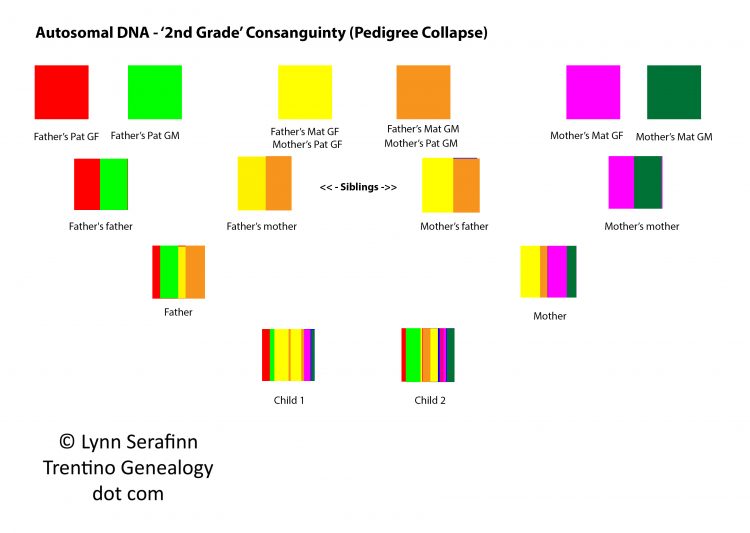 Click on image to see it larger in a new window.
Click on image to see it larger in a new window.
Instead of the expected eight grandparents for Mother and Father, we have only SIX. This is why we call it a ‘collapse’: instead of the number of your ancestors multiplying by two at every generation, whenever there is a consanguineous marriage, there will be fewer than the expected number of ancestors – two fewer if both ancestors are shared, and one fewer if only one of them is shared (e.g. if Father’s mother and Mother’s father we step-siblings instead of full siblings).
Really, pedigree collapses are a simple matter of statistics: If we look back at the human population of the planet over the millennia, doubling our ancestors at every generation is mathematical impossibility. There simply weren’t enough people living on the planet for us to have two completely unrelated ancestors for every generation in our history.
SIDE NOTE: In the future I will be publishing an article on this site discussing how to recognise consanguineous marriages and pedigree collapses in your family tree, and also how to USE these as clues to piecing together genealogical riddles in earlier generations.
Collapsing the ‘Gene Pool’
Have a look now at the two CHILDREN of the consanguineous couple in the diagram above. Do you notice anything different compared to the earlier diagram were there were eight great-grandparents?
I’ve deliberately exaggerated the results for purpose of demonstration, but if you look closely at Child 1, you might notice he/she has TWO sets of yellow DNA. In fact, the amount of yellow in the diagram (and remember, it’s just my own drawing, and isn’t scientific) is close to 50% of the child’s DNA. This is because Child 1 just happened to get a double whammy of ‘yellow’ from both Mother and Father, via their shared ancestor.
Let’s consider some of the implications for the children in this diagram:
- Child 1 and 2 are not just siblings; they are also 1st cousins, 1st removed.
- If Child 1 were to grow up and marry yet another close descendant (another 1st cousin, for example) of the ‘yellow’ great-grandfather, there is a strong chance that their children would inherit and even higher percentage of ‘yellow’ DNA, for the simple reason that there is that much less diversity in the genes to pass on to their descendants. If that DNA happened to contain genes associated for certain health conditions that were normally ‘recessive’, it would make that child more susceptible to developing those conditions. This is what happened to many of the European royal families, including Queen Victoria’s family and the Hapsburgs.
- Child 2’s genes appear to be a bit more evenly spread out, but there is always a chance that he/she has also inherited the recessive gene for a disease or serious health condition. So if this child marries another closely related descendant of the ‘yellow’ grandfather, there may be a higher risk that the condition will get ‘switched on’ in the next generation.
Even though you might discover many pedigree collapses in your family tree, a marriage between cousins does not automatically mean their children will inherit health risks. Moreover, marriages between more distant cousins (3rd and 4th cousin marriages were fairly common in the past) still allowed for a fairly diverse ‘gene pool’, especially if cousins from the SAME lineage did not intermarry at the next generation. Consanguinity between marital partners only becomes a genetic risk when close cousins intermarry repeatedly throughout the generations, without ever (or hardly ever) introducing ‘fresh blood’ into the gene pool. This was not the case for most of our ancestors
How Pedigree Collapses Affect Your DNA Test Results
Many people do DNA testing to find and connect with living relatives. Sites like Ancestry can sometimes give you lists of hundreds of ‘cousins’, with whom you share at least SOME DNA according to their tests. Sometimes these DNA matches show up as ‘probable’ 2nd, 3rd or 4th cousins. But others might show up as ‘3rd to distant cousins’ or something equally vague.
One of the reasons for such vagueness is the presence of (possibly many) pedigree collapses.
Because endogamy can cause your genes to become more ‘saturated’ (for lack of a better word) with the genes of certain ancestral lines, a cousin might show up who shares enough common genetic material to be your 3rd cousin in theory, but in fact is your 6th (or even more distant) cousin. Thus, if the two of you try to find your common ancestors at the 3rd cousin level (great-great-grandparents), you simply won’t find them, and are likely to become confused (and possibly doubtful about your own family tree) if you try to.
Moreover, the more pedigree collapses each of you has in your ancestry, the more ‘off’ these estimates will be.
The only way to SEE how you are connected is for both of you to have traced your family history – through genealogy, not DNA.
My gut tells me (although this is just a HUNCH based on logic, and not any scientific evidence) that endogamy can also skew our ethnicity reports. In other words, if the genes for one ancestral line are disproportionately pronounced in our DNA due to pedigree collapses, would it not give the ‘appearance’ of us being ‘more’ of something than we actually are? For example, if we had inherited a lot of ‘yellow’, and ‘yellow’ was associated with a particular ethnic or geographic group in a tester’s DNA database, wouldn’t our ethnicity reports show us as being a high percentage of whatever that ethnicity happened to be – even if it weren’t the ethnic group to which we believed we belong?
To get into the heart of such a ‘loaded’ question, we first need to get clear about what exactly ethnicity is – and what it is not – as well as how DNA testing sites ARRIVE at their ‘ethnicity estimates’.
Coming Up Next Time…
This seems like the perfect place to end the first instalment of this article series, as next time, in Article 2, we will be addressing the next topic on our list, namely:
- PART 3: Why DNA Testing is NOT a Substitute for Genealogical Research
In that article, we will examine some of the misconceptions people have about DNA tests, how relationship estimates are formed to identify ‘DNA Matches’, and the many the challenges around identifying your connections with DNA matches. We’ll also look at the technique of ‘triangulation’, as well as how ‘endogamy’ can sometimes blur relationship estimates.
YOU CAN READ IT NOW AT:
I invite you to subscribe to the Trentino Genealogy blog, to make sure you receive all the articles in the special series on DNA testing, as well as all our future articles. After the series is complete, I will also be compiling all the articles into a FREE downloadable PDF available for a limited time to all subscribers. If you are viewing online you will find the subscription form on the right side at the top of your screen. If you are viewing on a mobile device and cannot see the form, you can subscribe by sending a blank email to trentinogenealogy@getresponse.net.
(Closing thought: If you are interested to go more deeply into the fascinating world of genetics, I highly recommend checking out the beautifully written book called A Brief History of Everyone Who Ever Lived: the stories of our genes by Adam Rutherford. I assure you it is NOT overly scientific; rather it’s extremely engaging and often funny. I think it’s a terrific book title too.)

I look forward to your comments. Please feel free to share your own research discoveries in the comments box below.
Warm wishes,
Lynn Serafinn
P.S. My next trip to Trento will be in February and March 2019.
If are considering asking me to do some research for you while I am there, please first read my ‘Genealogy Services’ page, and then drop me a line using the Contact form on this site. Then, can set up a free 30-minute chat to discuss your project.
P.P.S.: Whether you are a beginner or an advanced researcher, if you have Trentino ancestry, I invite you to come join the conversation in our Trentino Genealogy group on Facebook.
Subscribe to receive all upcoming articles from
Trentino Genealogy!
Desktop viewers can subscribe using the form
at the right side at the top of your screen.
If you are viewing on a mobile device and cannot see the form,
you can subscribe by sending a blank email to trentinogenealogy@getresponse.net.
Lynn on Twitter: http://twitter.com/LynnSerafinn
Join our Trentino Genealogy Group on Facebook: http://facebook.com/groups/TrentinoGenealogy
View my Santa Croce del Bleggio Family Tree on Ancestry: https://www.ancestry.com/family-tree/tree/161928829

